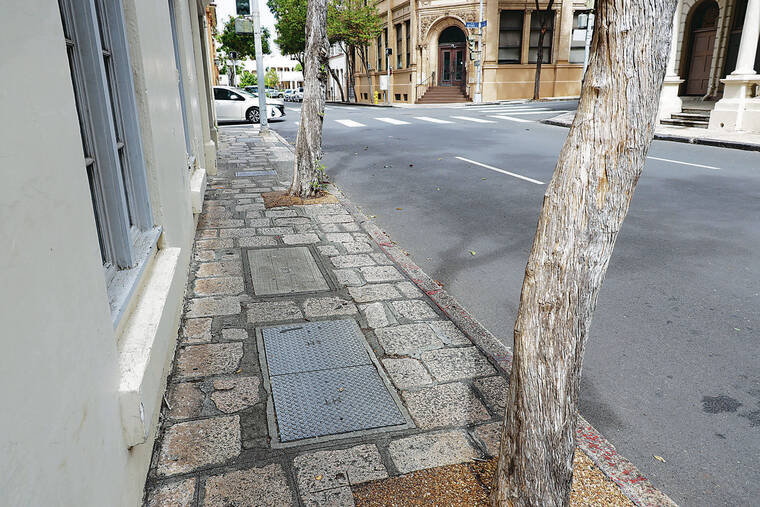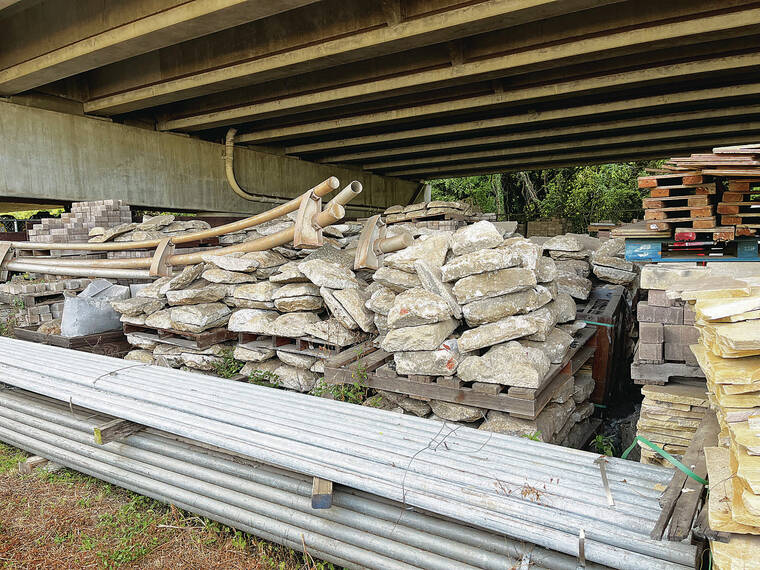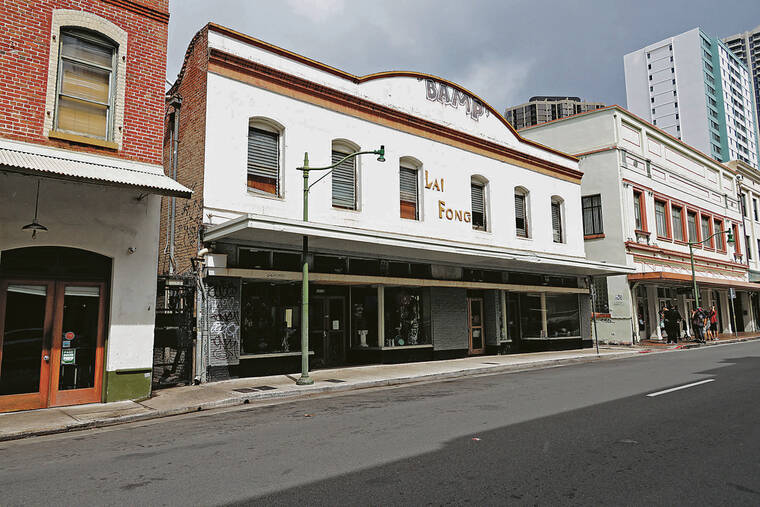The City and County of Honolulu isn’t being a good steward of historic stone sidewalks and street curbs, according to a commission established in 2023 to protect and preserve historic resources on Oahu.
The Oahu Historic Preservation Commission is raising concerns about the lack of a city policy or plans to preserve or reuse granite stone sidewalks that have existed in parts of Chinatown and downtown Honolulu for over a century, as well as historic lava rock curbs that for many years have been disappearing from downtown streets and other old Honolulu neighborhoods.
On Sept. 26, commission Chair Kehaunani Abad sent a letter to Mayor Rick Blangiardi and two other city officials expressing concern over the city stockpiling, or allowing contractors to discard, the historic granite sidewalk pavers, granite curbs and lava rock curbs.
The letter in part was prompted by a city contractor removing granite sidewalk stones fronting the Lai Fong store on Nuuanu Avenue in Chinatown last year to smooth out the walkway, and discarding the stones despite their long-recognized historic significance.
Abad’s letter also included photos of stockpiles the city has accumulated of historic granite and lava rock stones removed from streets and sidewalks over decades without any plan to put them back or find new uses for them.
“It’s such an absurd situation,” Glenn Mason, a local restoration architect and commission member who largely drafted the letter, said at a Tuesday commission meeting.
Mason in an interview said granite sidewalk pavers and curbs, including many from China, relate to the decimation of Hawaii sandalwood forests when the valuable wood was widely harvested and exported on foreign cargo ships that would arrive in Honolulu with little cargo and slabs of heavy granite used as ballast. Rock ballast also was used as part of Hawaii sugar exports to the mainland.
According to documentation supporting the downtown Honolulu Merchant Street Commercial and Civic Historic District that was listed on the National Register of Historic Places in 1973, “Lightly loaded ships would fill their ballast with granite stones, which were unloaded at port in Honolulu when the ships were filled with more valuable cargo such as sandalwood. Those ballast stones were then cut and used to pave sidewalks and to create curbs in areas close to the harbor.”
Granite paver stones tended to be 18 inches square with varied thickness and cemented in place with mortar, the register filing said.
Lava rock curbs were quarried locally from around the 1880s to 1950s, according to Mason, and can be found downtown and in older Honolulu neighborhoods including Manoa and Kaimuki.
Willa Trimble, a local architect who works downtown, said the granite and lava rock sidewalk and curb stones are a unique and special character layer of the area. “If we replace them with generic materials, we lose that character and history,” she said.
Blangiardi and the other two recipients of the letter, city Managing Director Michael Formby and Dawn Takeuchi Apuna, director of the city Department of Planning and Permitting, have yet to respond to the commission.
Scott Humber, the mayor’s communications director, said in an email that the city will work with the commission to look at opportunities to retain, inventory and potentially make use of historic sidewalk paver stones and curbs.
The city, Humber added, has implemented several changes for sidewalk reconstruction contracts in the wake of what happened fronting the Lai Fong store, a reconstruction project prompted by DPP to address what it determined to be a trip hazard.
Humber said DPP now indicates areas where historic sidewalks may exist as part of sidewalk work requests sent to the Department of Facility Maintenance, which then confirms whether historic stone curbs or pavers are present.
Facility Maintenance also now participates in regular meetings with the city Department of Design and Construction and the State Historic Preservation Division to review projects and determine if SHPD oversight is required, according to Humber, who also said SHPD now reviews and approves sidewalk reconstruction and other DFM projects before contractors begin work.
Still, the commission suggests that historic granite pavers be reset if they need to be removed for work, including to make a walking surface more even, and that historic stone curbs be replaced after construction instead of pouring concrete for new sidewalks or curbs.
“Given that these are historic materials, the City should not discard them, but having no plan for their reuse means the quantity of these materials keeps increasing and stored away, their historic importance is hidden,” the commission’s letter said.
Discarding or stockpiling historic stone sidewalk pavers and curb pieces has been an issue in Honolulu for decades.
Kai White, another commission member, recalled historic stones being removed and not replaced as part of past road drainage improvement work around the city, especially in Kakaako. The only historic mitigation requirement, she said during Tuesday’s meeting, was to photograph what was removed.
“There has to be some kind of education to these contractors that this is part of the oldest history of the built environment in Honolulu,” White said.
In 2001 a contractor doing work for the city gave then-City Managing Director Ben Lee about 40 segments of lava rock curb stones so Lee could build a walkway at his house even though the city has stockpiled lava rock curb stones removed from streets at least since the 1970s.
Representatives of Lee and Royal Contracting Inc. in 2003 claimed that the curbstones, each about three feet long and two feet in depth, had no value and that many were irregularly shaped.
A State Historic Preservation Division official at the time said the stones had historic value and should be protected under state law.
After publicity of the issue, Lee, who had yet to build his walkway, returned the stones.
Humber said city officials are currently uncertain whether state law requires the city to retain and store historic sidewalk and curb stones, the latter of which can weigh over 300 pounds apiece and are difficult to work with as opposed to concrete.
Humber also said that on some occasions Facility Maintenance uses stones from its stockpile to replace damaged stones on sidewalks or streets.
Mason said at the commission’s Tuesday meeting that the city should stop removing and not replacing historic stones as part of construction projects, and find ways to make use of the existing stockpiles.
“The first step is to stop more stones from going there,” he said, referring to the stockpiles. “I think the next step is figuring out what you do with all those stones … because it’s absurd to have accumulated all of these things for decades and not have any plan to use them.”








We got several piles of similar stones (smaller, more short, rectangular pieces) from a cobble-stone driveway in Hawaii Kai back in 1986, stockpiled them, and used in our landscape business for years as edges for landscapes, ornamental borders for cement work, and sold some to others for their uses. We were aware of the history back then. Still using the last of the piles for home landscape. The source was a private property, not a public sidewalk. But I still notice these in places around town. Good to be aware and appreciate such things. Adaptive re-use preserves our links to the past.